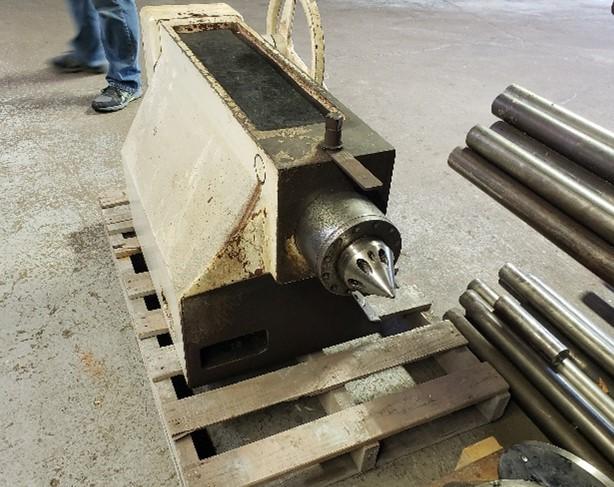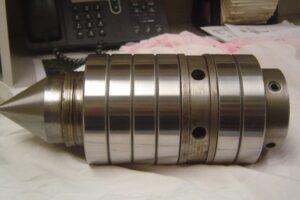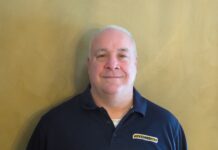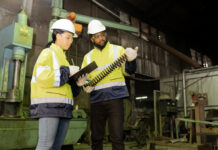
Established in 1969, Riten Industries, Inc. is the largest domestic manufacturer of live centers, dead centers, and face drivers in the work holding industry.
A growing part of their re-engineering platform, Riten is at the forefront of leveraging solutions to eliminate costly machine downtime due to tailstock failure. The fact is that a lot of machinery becomes obsolete before its time, and the original OEM may not exist anymore to provide timely replacements. If a machine becomes obsolete, Riten has developed a dedicated tailstock ‘rebuild-repair’ program that includes a bearing assembly inventory platform that allows manufacturers to strategically schedule downtime.
RITEN TAILSTOCK REBUILD-REPAIR PROCESS
Some tailstock projects are quoted by Riten based on existing lathe assembly drawings. A budgetary proposal is provided for a repair based on these drawings, with the understanding that it is subject to change based on the condition of the tool as received. From there, Riten executes their established tailstock repair process.
STEP ONE
Upon receipt, the tool is photographed and a project folder is assigned containing detailed inspection forms tailored to the scope of the project. Riten’s Repair Department then disassembles the tool−documenting the process with notes and photographs specific to each step.
Once the tool is fully disassembled, a bill of material is created detailing all the essential components.
STEP TWO
The components go to Inspection, where a visual review is performed in addition to taking vital measurements. All of the key inspections and fits are documented in the project folder, which details both the inspection process and the expected inspections. Key inspection variables include:
- The fit between the quill OD and the tailstock ID
- The fit between the quill ID and the OD of the bearings
- The spindle bearing journals and the bearing ID
- The spindle point and the bearing journals between centers to determine concentricity
- The Morse taper ID (if the spindle has an ID taper instead of a point)
STEP THREE
The folder goes to quoting, where an engineer reviews the scope of the project and the inspection findings. A quote is then created based on the condition of the spindle as received.
STEP FOUR
The inspection findings and the preliminary quote are presented to the customer. Based on feedback from the customer, the scope of work is finalized. Also, if it is determined that if the parts don’t exist, they will proceed to retrofit, rebuild, redesign headstock or tailstock assemblies.
 DEISTER MACHINE / REBUILD-REPAIR CASE-IN-POINT
DEISTER MACHINE / REBUILD-REPAIR CASE-IN-POINT
Since 1912, Deister Machine Company, Inc. (Deister: Fort Wayne, IN) has been a leader in manufacturing quality specialized vibrating equipment for the mining, quarrying, and allied industries. The family-owned and operated company is a preferred manufacturer of vibrating feeding, scalping, and screening equipment. Deister is known for delivering reliable separating and sizing equipment that is engineered to operate hour-after-hour, day-after-day, with minimum attention and maintenance. Their products are uniquely engineered to significantly increase efficiency and productivity within key aggregate industries including: crushed stone, sand, gravel, asphalt, coal, coke, slag, and ore processing.
Deister’s dedicated aggregate capital equipment portfolio includes machinery for inclined screens, high-speed screens, horizontal screens, asphalt-batch plant, asphalt-drum mix, dewatering screens, feeders and grizzlys, and electro-mechanical feeders. In 2006, Deister realized that their lathes required excessively frequent maintenance, which was affecting their production output and resulting in costly downtime. In turn, they contacted Riten who swiftly performed essential inspection-and-failure analysis on one of their two lathes.
Based on their findings, Riten designed and manufactured a new quill with an upgraded four-piece bearing design. This new design was an upgrade with more capacity than the existing bearing design. They also designed and manufactured a replaceable point spindle instead of the existing solid spindle, since the customer noted that the spindle points of their existing lathes were easily damaged. This new design was highly efficient and performed much better than the old design.
A year later, however, Deister came back with a desire to achieve additional bearing life. Riten then initiated a review of the application on-site and discovered that part of the process involved an eccentric load that they were not aware of. Eccentric loads are very hard on both the bearing assembly and the spindle of the lathe.
The review revealed that Deister was turning shafts that weigh between 1,500–3,000 pounds. Once these are turned complete, they cut a new center hole that is offset (not on-center) and turn a new bearing journal−resulting in a shaft that is unbalanced. In effect, a heavy, eccentric shaft spinning at high RPM can literally walk-the-machine across the floor, which is extremely hard on the equipment and its effective lifespan. However, this shaft design is key to the performance of equipment Deister is known for.
Again, after reviewing the application on-site, Riten suggested key changes to both the process and their selection of dead centers. In addition to premature wear on the bearing assemblies, they were breaking dead centers−a vital safety concern. In many cases, their center hole sizes were inadequate, therefore, charts were provided that specified minimum center hole sizes based on the weight of the part.
Additionally, the bearing assembly in the new unit was upgraded to a matched set of six angular contact bearings. The existing four-bearing assembly was replaced with a six-bearing assembly in the same custom quill. When designing the quill, room was left in the assembly for additional bearings−if they proved necessary.
Another key downtime dilemma is delivery on a bearing assembly, which can be anywhere from 12–20 weeks depending on availability of the base bearing. The bearing manufacturer starts with a standard high precision bearing and reworks them into a six-bearing matched set. Riten orders and inventories a spare bearing assembly with every customer repair. This is essential for limiting production downtime for a repair−reducing downtime to 2–3 weeks vs. 3–5 months for the repair.
CONCLUSION
Between 2006 & 2010, Riten upgraded a total of three Deister lathes−two of which are identical. They all share the same bearing assembly and replaceable point. The upgrade included manufacturing new quills with replaceable point spindles and honing the tailstock to fit. Notably, the new tools were installed on-site.
With this established ‘shut-down elimination’ program in place, Deister continues to have Riten refurbish one of their lathes each year during their slow season−with each lathe being refurbished approximately every 2–4 years depending on their usage.
According to Riten’s V.P. of Manufacturing, Mitchell Kirby, “It’s imperative for companies to perform critical maintenance during seasonal downtimes on their lathes. Depending on business levels, more companies send us their damaged units annually for either refurbishment and/or replacement. We also manufacture spare identical quill assemblies for inventory. With this in place, we can limit their downtime to 3-5 days to remove the existing unit and mount the spare, whereas delivery on a replacement unit could be 14-18 weeks.”
About Riten Industries
Since 1933, Riten Industries, Inc. has established itself as the largest domestic manufacturer of Live and Dead Centers and Face Drivers. With thousands of standard products in this focused area, no other company can match our experience and engineering skill to meet the demanding needs of the work holding industry. Made-in-the-USA at Riten’s 35,000 sq. ft. production facility in central Ohio, we boast the industry’s broadest line of standard products and can also design custom specials to meet a customer’s unique needs. Our quality system is certified annually to meet the demanding requirements of ISO-9001: 2015. Notably, Riten also has a dedicated full-time department for repairing and rebuilding used live and dead centers−the only one of its kind in North America.
By: Kent Hizer, Riten Industries, Inc
Author: Kent Hizer / Riten Industries, Inc. / 574.850.4118 /
k.hizer@riten.com
Editorial & Photo Contact: Ray Farrar / Method Media LLC / 216.861.0862 / rayf@methmedia.net


















